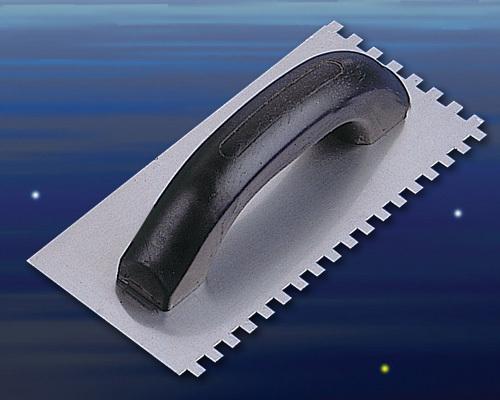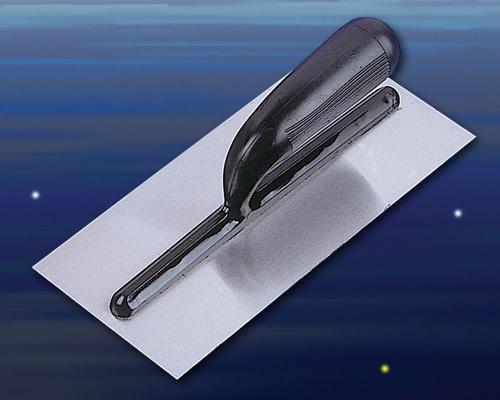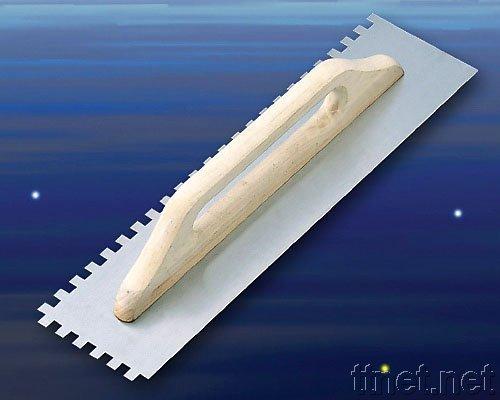Tile installation tools
 Tile installation tools
Tile installation tools
Company: YING FU HARDWARE & TOOL CORP.
Telephone: 886-4-778-0652
Fax: 886-4-776-8652
E-Mail: yingfu.hardware@gmail.com
Address: 38-22 Fanpo St., Fanpo Village, Fuhsing Township, Changhua County, Taiwan 506
In the world of tile installation, few tools are as fundamental and indispensable as the Notch Trowel. These unassuming yet highly specialized tools play a critical role in ensuring the success of any tiling project. In this article, we will explore the significance of Notch Trowels in tile installation, their various types, and best practices for using them effectively.
The Role of Notch Trowels in Tile Installation:
Notch Trowels are designed to evenly spread adhesive or mortar on the substrate before placing tiles. They create a uniform bed of adhesive with specific ridges or notches that serve several essential functions:
Adhesive Distribution: Notch Trowels distribute adhesive evenly across the substrate, preventing air pockets and ensuring strong tile-to-substrate adhesion.
Tile Alignment: The ridges or notches created by the trowel help align and level the tiles, resulting in a visually appealing and structurally sound tile installation.
Proper Coverage: Different trowel types and sizes provide varying levels of adhesive coverage. This ensures that the tiles bond securely without excess adhesive seeping through the tile joints.
Types of Notch Trowels:
Notch Trowels come in a variety of shapes and sizes, each designed for specific tile types and installation requirements. Here are some common types:
Square-Notch Trowel: This trowel features square-shaped notches and is commonly used for standard ceramic or porcelain tiles. The size of the notches varies to accommodate different tile sizes and adhesive thicknesses.
V-Notch Trowel: V-Notch Trowels have notches shaped like a "V" and are ideal for mosaic tiles and smaller-format tiles. The sharp angles of the notches provide better adhesive bonding for smaller tiles.
U-Notch Trowel: U-Notch Trowels have U-shaped notches and are often used for larger tiles, natural stone tiles, and thick-set mortar applications. The U-shape allows for a more substantial adhesive layer.
Best Practices for Effective Use:
To achieve the best results with Notch Trowels, consider the following best practices:
Select the Right Trowel: Choose the trowel type and size that align with your tile size and adhesive requirements. Refer to the tile manufacturer's recommendations for guidance.
Maintain Consistent Angle: Hold the trowel at a consistent angle to create uniform ridges. This ensures even adhesive distribution and tile alignment.
Work in Small Sections: Only spread adhesive in areas where you can lay tiles within a reasonable timeframe. Adhesive can dry quickly, especially in warm or dry conditions.
Back-Buttering: For larger or irregularly shaped tiles, apply a thin layer of adhesive directly to the tile's back. This helps ensure adequate coverage and bonding.
Conclusion:
Notch Trowels may seem like simple tools, but their role in tile installation is paramount. They contribute to the aesthetics, durability, and overall success of tiling projects. By choosing the right type and size of Notch Trowel and following best practices for their use, tile installers can achieve professional results and create beautiful, long-lasting tile installations. These unassuming tools truly stand as essential pillars in the world of tile installation.
Notch Trowels, like any other tools, require proper maintenance to ensure their longevity and consistent performance. Neglecting maintenance can lead to subpar tiling results and the premature wear and tear of your trowel. Here are some essential tips for maintaining and cleaning your Notch Trowel:
Cleaning after Use:
After each use, it's crucial to clean your Notch Trowel thoroughly. Follow these steps:
Remove Excess Adhesive: Use a putty knife or scraper to remove any excess adhesive or mortar from the trowel's surface. This prevents build-up that can interfere with the trowel's notching function.
Soak in Warm Water: Soak the trowel in warm, soapy water for a few minutes. This will help soften and loosen any remaining adhesive.
Scrub Gently: Use a brush or sponge to scrub away the softened adhesive. Be gentle to avoid damaging the notches or the trowel's blade.
Rinse Thoroughly: Rinse the trowel with clean water to remove any soap residue and remaining debris.
Dry Completely: Ensure the trowel is completely dry before storing it. Moisture can lead to rust, especially if the trowel is made of steel.
Removing Stubborn Residue:
If adhesive or mortar has dried and become stubborn to remove, you can use a few additional techniques:
Soak Longer: Allow the trowel to soak in warm, soapy water for an extended period to further soften the residue.
Use a Wire Brush: A wire brush can be effective in scrubbing away stubborn adhesive. Be cautious not to scratch the trowel's surface excessively.
Chemical Adhesive Remover: In extreme cases, you can use a chemical adhesive remover following the manufacturer's instructions. Exercise caution and ensure proper ventilation when using chemicals.
Inspect for Damage:
Regularly inspect your Notch Trowel for any signs of damage, such as bent or broken notches, cracks, or corrosion. Replace any damaged trowels promptly, as compromised tools can result in uneven adhesive distribution and tile misalignment.
Proper Storage:
Store your Notch Trowels in a clean, dry place. Avoid leaving them in damp or humid environments, as moisture can lead to rust. Hanging them on a pegboard or tool rack is an excellent way to keep them organized and prevent contact with other tools that may cause damage.
Sharpening and Maintenance for Metal Trowels:
For metal Notch Trowels, occasional sharpening may be necessary to maintain the effectiveness of the notches. You can use a metal file or sharpening stone to carefully restore the sharpness of the notches. Always follow proper sharpening techniques to avoid altering the trowel's shape or notches.
In conclusion, proper maintenance and cleaning are essential for extending the life and ensuring the optimal performance of your Notch Trowel. By following these guidelines and taking care of your trowel, you can continue to achieve professional-quality tile installations and enjoy the benefits of this essential tool for years to come.
The world of construction tools is not immune to technological advancements, and Notch Trowels are no exception. In recent years, there have been significant innovations in Notch Trowel technology aimed at improving efficiency and precision in tile installation. Let's explore some of the latest developments:
1. Ergonomic Handle Designs:
One of the primary areas of innovation in Notch Trowel technology has been in the design of ergonomic handles. Manufacturers are now incorporating comfort and user-friendliness into their trowel handles. These new designs reduce strain on the user's wrist and hand, making extended periods of tiling less fatiguing.
2. Adjustable Notch Trowels:
Adjustable Notch Trowels have gained popularity for their versatility. These trowels feature interchangeable notched plates that allow users to switch between different notch sizes and configurations quickly. This adaptability is particularly useful when working on projects that require various adhesive thicknesses or tile sizes.
3. Laser-Cut Notches:
Laser-cutting technology has revolutionized the precision of notch patterns on trowels. Manufacturers can now create incredibly uniform and sharp notches that enhance adhesive distribution and tile alignment. The result is a smoother and more efficient tiling process.
4. Notch Trowels with Built-in Leveling Systems:
Some Notch Trowels now come equipped with built-in leveling systems. These systems help ensure that tiles are laid flat and level, reducing the need for additional leveling tools and improving the overall quality of tile installations.
5. Lightweight Materials:
Innovations in materials have led to the development of lightweight yet durable Notch Trowels. These trowels are easier to handle and reduce user fatigue during long tiling projects.
6. Anti-Corrosion Coatings:
Manufacturers are increasingly applying anti-corrosion coatings to their trowels. This extra layer of protection helps extend the trowel's lifespan, especially in environments where exposure to moisture or harsh chemicals is common.
7. Smart Trowel Technology:
Some companies have ventured into the realm of "smart" Notch Trowels. These trowels may be equipped with sensors or Bluetooth connectivity to provide real-time feedback on adhesive thickness, pressure, and coverage. While these innovations are still in their infancy, they hold the promise of enhancing precision and reducing errors in tile installation.
8. Environmentally Friendly Materials:
As sustainability becomes a focal point in construction, manufacturers are exploring eco-friendly materials for Notch Trowels. These materials are not only durable but also have a reduced environmental impact.
Conclusion:
The continued evolution of Notch Trowel technology reflects the industry's commitment to enhancing the tile installation process. These innovations aim to make tiling projects more efficient, precise, and user-friendly, ultimately benefiting both professionals and DIY enthusiasts. As technology continues to advance, we can anticipate even more exciting developments in the world of Notch Trowels, further elevating the art of tile installation.
In the digital age, technology has also made its mark on the tile installation process through digital tools and software. These tools are designed to assist tile installers in selecting the right Notch Trowel and planning the layout of their tiles effectively. Here are some notable advancements in this area:
Trowel Selector Apps: Some manufacturers and third-party developers have created mobile applications that help installers choose the appropriate Notch Trowel for their specific tile and adhesive combination. These apps consider factors such as tile size, adhesive type, and substrate material to recommend the ideal trowel size and notch configuration.
Tile Layout Software: Tile layout software has become increasingly sophisticated, allowing installers to create detailed digital plans for their tile projects. These tools help visualize how tiles will fit within a space, taking into account the dimensions of the room and any design considerations. Installers can experiment with different patterns and layouts before physically laying the tiles.
Augmented Reality (AR): AR technology is being used to assist installers during the tiling process. Installers can use AR apps or devices to overlay digital tile layouts onto the physical space, ensuring precise placement of tiles and alignment with the chosen design.
Tile Estimation and Cost Calculation: Some digital tools offer features for estimating the number of tiles needed for a project and calculating material costs. This helps installers plan their budget and materials accurately.
Digital Measurement Tools: Installers can use digital measurement tools, such as laser distance meters, to quickly and accurately measure room dimensions and tile placements. These measurements can be fed into layout software for precise planning.
Remote Collaboration: With the rise of remote work and collaboration, digital tools enable installers to share project plans, measurements, and progress with clients and colleagues in real-time. This facilitates communication and ensures that everyone involved in the project is on the same page.
Online Communities and Forums: Online platforms and communities dedicated to tile installation provide a wealth of knowledge and resources for installers. Professionals can exchange tips, best practices, and troubleshooting advice, enhancing their skills and staying updated on industry trends.
Conclusion:
The integration of digital tools into the tile installation process has streamlined workflows, improved accuracy, and expanded the resources available to professionals in the field. Whether it's selecting the right Notch Trowel, planning intricate tile layouts, or collaborating with clients and peers, these digital advancements are revolutionizing the way tile installation projects are executed. As technology continues to evolve, tile installers can expect even more innovative solutions to enhance their craft.

